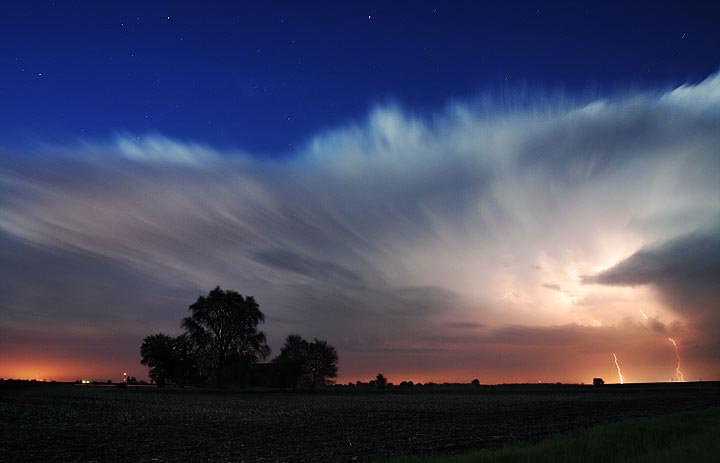The Weather Bowl
 [Image: A passing Illinois lightning storm and supercell, the clouds peeling away to reveal evening stars; photo ©Extreme Instability/Mike Hollingshead. If you can overlook pet photos, meanwhile, don't miss Hollingshead's other storm work from 2006 and 2005 – including these Nebraskan auroras. While you're at it, this storm sequence has some stunning, pre-storm landscape shots].
[Image: A passing Illinois lightning storm and supercell, the clouds peeling away to reveal evening stars; photo ©Extreme Instability/Mike Hollingshead. If you can overlook pet photos, meanwhile, don't miss Hollingshead's other storm work from 2006 and 2005 – including these Nebraskan auroras. While you're at it, this storm sequence has some stunning, pre-storm landscape shots].During a disastrously moderated talk at the MAK Center last night in West Hollywood, where the panelists could hardly get a word in edgewise because of the barely coherent, self-answering, 40-minute monologue of the moderator, Karl Chu briefly managed to say that he was interested in constructing and designing whole continents and weather systems.
Which got me thinking.
Given time, some digging equipment, a bit of geotechnical expertise, and loads of money, for instance, you could turn the entirety of greater Los Angeles into a weather bowl, dedicated to the recreation of famous storms. Install some rotating fans and open-air wind tunnels, build some deflection screens in the Hollywood Hills, scatter smaller fans and blowers throughout Culver City or overlooking Burbank, amplify the natural sea winds blowing in through Long Beach – and you could re-enact famous weather systems of the 18th and 19th centuries, reproducing hurricanes, even bringing back, for one night, the notorious storm that killed Shelley.
You consult your table of weather histories, choose your storm and go: fans deep in hillsides start turning, the wind tunnels roar, and lo! The exact speed and direction of Hurricane Andrew is unleashed. Seed the clouds a bit and reprogram the fans, and you can precisely reproduce the atmospheric conditions from the night William Blake was born. Or the ice storm that leveled electrical gantries outside Montreal, now whirling in a snow-blurred haze through Echo Park.
You could build competing weather colosseums in London, San Francisco, Tokyo, and Beijing. Every night new storms are reenacted, moving upward in scale and complexity. The storm Goethe saw as a nineteen year-old, contemplating European history, kills a family of seven outside Nanking. You soon get Weather Olympics, or a new Pritzker Prize for Best Weather Effects.
One day, a man consumed with nostalgia hacks the control program to recreate the exact breeze on which he once flew a kite over the Monbijouplatz in Berlin...
(For more on the construction of continents, see The Transgondwanan Supermountain. For more on the exhibition now up at the MAK Center, download this PDF).





Comments are moderated.
If it's not spam, it will appear here shortly!
Can I put in a vote to recreate the landmark storm of my youth: the great English "hurricane" of 1987. This would have to be a surprise, no-advance-warning, guerilla storm-event, with emergency supplies of tea for those caught unawares. And, importantly, the next day off school!
Or the lightning storm during which Ben Franklin did the key thing.
Or, speaking of Shelley, you could recreate the weather from that now-famous evening in Switzerland, when Mary came up with Frankenstein. See what ideas people come up with, the second time around.
I know this is an old post but it is amazing. I originally studied meteorology and now am in locative media and currently working on augmented reality, architecture and spaces.
What a beautiful rumination on an amazing site.
I am also in l.a
my name is jeremy hight
I used to wonder about the mountain ranges east of the L.A basin and how it broke the desert storms down on monsoonal flows and kept l.a from that semi-ecosystem and how they broke down the western storms with drying thus making the desert....what would happen if an area was removed that allowed a channel between the two like a funnel effect? would storms find a narrow passage or would a beautiful multi layered and multi leveled ruin fan out of the crevasse?
Very cool concept. I've lived all across the U.S. and experienced many of the different weather phenomena that we experience. It would be very interesting to be able to "re-create" weather from one part of the country for others to experience where they normally wouldn't.
Post a Comment